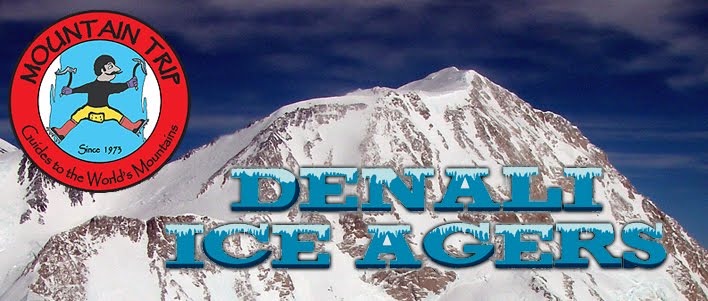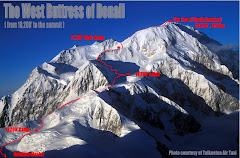Day job - for upper body strength, my day job is working at a warehouse that utilizes mechanical and human labor. I maximize the human labor by manually moving boxes that weigh up to 70 pounds. This helps to maintain my upper body strength and improve muscular coordination while in various positions. In addition, as a major climb approaches, I wear a weighted 40 pound backpack to maximize opportunities to do deep knee bends and increase aerobics while moving around the warehouse.
 Winter mountain (hill) - during the brief periods that Maryland experiences snow, I drive to western Maryland and train for six hours. Wearing snowshoes, I have a weighted 50 pound (23 kilo) back pack and pull a Denali expedition sled loaded with two 50-pound (45 kilo total) bags of sand. Pulling sleds is a love-hate relationship, but is an invaluable tool when attempting the West Buttress route on Denali, according to Denali guide and personal friend Coley Gentzel.
Winter mountain (hill) - during the brief periods that Maryland experiences snow, I drive to western Maryland and train for six hours. Wearing snowshoes, I have a weighted 50 pound (23 kilo) back pack and pull a Denali expedition sled loaded with two 50-pound (45 kilo total) bags of sand. Pulling sleds is a love-hate relationship, but is an invaluable tool when attempting the West Buttress route on Denali, according to Denali guide and personal friend Coley Gentzel. Beach - on days when Maryland is vacant of snow and the inclement weather keeps the crowds away from the Chesapeake Bay beaches, I will drag a 42 pound utility truck tire to simulate Denali sled usage. Snowshoes work great on the soft sand. However, this training has its
Beach - on days when Maryland is vacant of snow and the inclement weather keeps the crowds away from the Chesapeake Bay beaches, I will drag a 42 pound utility truck tire to simulate Denali sled usage. Snowshoes work great on the soft sand. However, this training has its drawbacks. Most significant are the delays caused by Homeland Security police investigating my unusual appearance and behavior near a key vehicle artery - the Chesapeake Bay Bridge. The Maryland Department of Natural Resources provided me with the tire because the sand was eating away at my expedition sled.
drawbacks. Most significant are the delays caused by Homeland Security police investigating my unusual appearance and behavior near a key vehicle artery - the Chesapeake Bay Bridge. The Maryland Department of Natural Resources provided me with the tire because the sand was eating away at my expedition sled.
In addition, on alternating weekends, I will utilize the hiking trails of Sugarloaf Mountain in Dickerson, Maryland. This simulates trail approaches to glaciers. No directly applicable to a Denali expedition, it does provide an aerobic training opportunity while enjoying the natural wilderness.
My reliance on non-conventional training methodologies enables me to maximize my training time and to better simulate climbing conditions expected on this expedition. Despite a year-round regiment of training, I am still prepared to suffer with dignity and humor, as is any good high altitude mountain climber.
Art Huseonica, Denali Ice Agers Expedition 2010 team member




As our expedition draws near, I'm continuing to train hard, especially with regards to my aerobic rate, keeping my pulse at 140-160 for selected periods of time. When I'm on the trail with a 55-pound backpack, this heart rate is easily achieved when moving uphill at a quick pace. I always use two Black Diamond ski poles to help maximize the workout.
ReplyDeleteDuring my training sessions, I wear a heart rate monitor keyed to my wristwatch. I also carry a pulse oximeter to check the oxygen saturation level of my blood. I'll carry this with me on Denali, to help monitor my acclimatization.
How's your training coming along Bob?
Cheers, Art H
Art (and team),
ReplyDeleteToday I was reminded of the importance of the "taper" phase of training.
We`ve all been bustin` our butts to improve cardio & strength fitness. My understanding is that in the process of cardio work, we train our bodies to depend upon anaerobic energy from our glycogen reserves.
My ortho doctor/marathoner friend told me today that it`s critical for me to use a 2-week period to scale back on training, so that my body can rebuild glycogen reserves, which I will need on our climb.
Great reminder, thought it was worth sharing.
Bob
Thx Bob for sharing your plan. My last significant training session will be one week before, on Sunday June 13th. I'm more concerned about injuries just prior to departing for a climb. Art H.
ReplyDelete